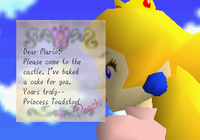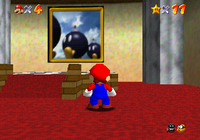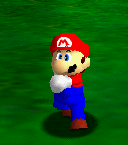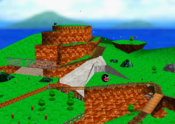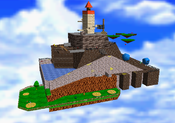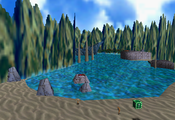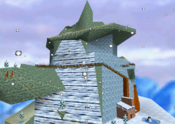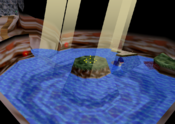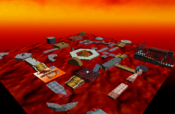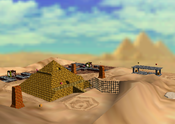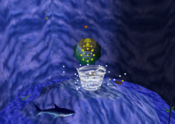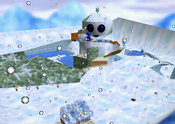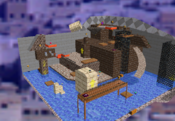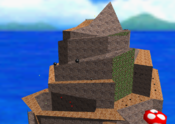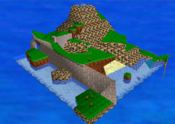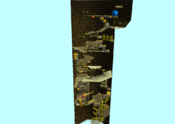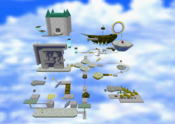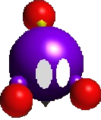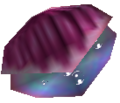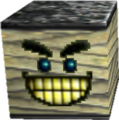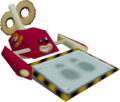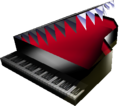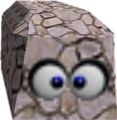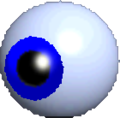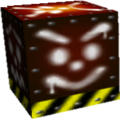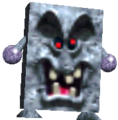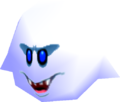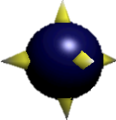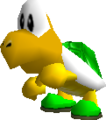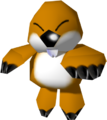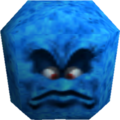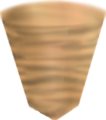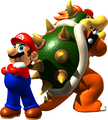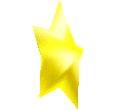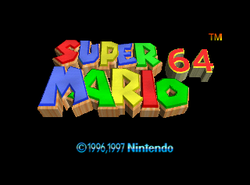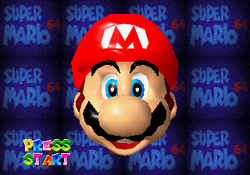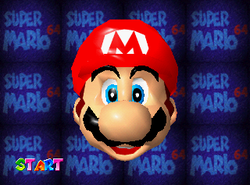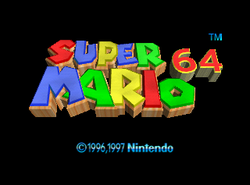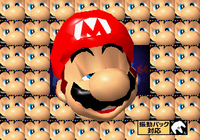Super Mario 64: Difference between revisions
SethAllen623 (talk | contribs) m (→Soundtrack) |
("So long kinga Bowser!" is actually just "So long Bowser!"; cited the official Nintendo 1996 Press Kit document.) |
||
| Line 624: | Line 624: | ||
==Reissues== | ==Reissues== | ||
===''Super Mario 64: Shindō Pak Taiō Version''=== | ===''Super Mario 64: Shindō Pak Taiō Version''=== | ||
''Super Mario 64: Shindō Pak Taiō Version'' is a version of the original game released in Japan on July 18, 1997 that includes [[Rumble Pak]] support. This game is the same as the international release of the game, as it retains all of the glitch fixes as well as graphical and sound changes (except Mario calling Bowser by his name in the "So long | ''Super Mario 64: Shindō Pak Taiō Version'' is a version of the original game released in Japan on July 18, 1997 that includes [[Rumble Pak]] support. This game is the same as the international release of the game, as it retains all of the glitch fixes as well as graphical and sound changes (except Mario calling Bowser by his name in the "So long Bowser!"<ref name="phrases">[https://web.archive.org/web/20150502183146/http://n64collection.co.uk/press-launch#page-zones__main-widgets__image72 Nintendo 1996 Holiday Season Press Kit (Oct 1996) - "SHHH...MARIO'S GOING TO SAY SOMETHING!"] ''n64collection.co.uk'' (May 2, 2015). Retrieved January 30, 2022. (Wayback Machine)</ref> voice clip, which was changed to "Buh-bye!"). Other differences include a new title screen Easter egg and the fixing of the "backwards long jump" glitch. This version was re-released for the Virtual Console on Wii in Japan on December 2, 2006, then on Wii U on April 8, 2015. | ||
===''Super Mario 64 DS''=== | ===''Super Mario 64 DS''=== | ||
| Line 693: | Line 693: | ||
**"I'm-a tired!" and the names of various pastas when Mario is sleeping. | **"I'm-a tired!" and the names of various pastas when Mario is sleeping. | ||
**"Mamma mia!" when falling out of a non-painting course after Mario loses a life. | **"Mamma mia!" when falling out of a non-painting course after Mario loses a life. | ||
**In the original Japanese version, Mario says "Here we go!" when he throws Bowser. In the American version, he only says "Here we go!" when throwing Bowser a short distance. When he throws Bowser a long distance, he instead says "So long | **In the original Japanese version, Mario says "Here we go!" when he throws Bowser. In the American version, he only says "Here we go!" when throwing Bowser a short distance. When he throws Bowser a long distance, he instead says "So long Bowser!". <ref name="phrases"/> | ||
**Similarly, when Mario hits a wall in the Japanese version, he grunts. In the American version, Mario grunts if he hits a wall at a low speed, but says "D'oh!" if he [[Long Jump]]s or dives into a wall. | **Similarly, when Mario hits a wall in the Japanese version, he grunts. In the American version, Mario grunts if he hits a wall at a low speed, but says "D'oh!" if he [[Long Jump]]s or dives into a wall. | ||
**When Mario [[Triple Jump]]s in the Japanese release, he says "Yahoo!". In the American release, he randomly says any of "Yahoo!", "Wha-ha!", or "Yipee!"; however, he says only "Yahoo!" when using the improved Triple Jump obtained after talking to Yoshi. | **When Mario [[Triple Jump]]s in the Japanese release, he says "Yahoo!". In the American release, he randomly says any of "Yahoo!", "Wha-ha!", or "Yipee!"; however, he says only "Yahoo!" when using the improved Triple Jump obtained after talking to Yoshi. | ||
| Line 769: | Line 769: | ||
*A notice in the lower right corner of the intro screen informs players that this release is compatible with the Rumble Pak. | *A notice in the lower right corner of the intro screen informs players that this release is compatible with the Rumble Pak. | ||
*If the player presses {{button|n64|Z}} on the intro screen, the background will be filled with images of Mario's face. These faces are copied from the frame buffer, so they move in synchronisation with the the modeled Mario face. | *If the player presses {{button|n64|Z}} on the intro screen, the background will be filled with images of Mario's face. These faces are copied from the frame buffer, so they move in synchronisation with the the modeled Mario face. | ||
*The voice line "So long | *The voice line "So long Bowser!"<ref name="phrases"/> is changed to "Buh-bye!", likely since Bowser's Japanese name is Koopa. | ||
*Mario's [[Double Jump (consecutive)|Double Jump]] sound is a higher pitched version of the same sound from the European and Australian version. | *Mario's [[Double Jump (consecutive)|Double Jump]] sound is a higher pitched version of the same sound from the European and Australian version. | ||
*One of Mario's single [[Jump]] sounds is higher-pitched. | *One of Mario's single [[Jump]] sounds is higher-pitched. | ||
Revision as of 08:52, January 30, 2022
Template:Infobox Super Mario 64 is a 3D platformer game released for the Nintendo 64 in 1996 for Japan and North America and in 1997 for Europe and Australia. This game was one of two (three in Japan) launch titles for the Nintendo 64, along with Pilotwings 64, which helped drive initial sales of the console. Since its release, Super Mario 64 has been widely acclaimed as one of the greatest and most important games of all time.[1][2][3]
Though not the first 3D platforming game, Super Mario 64 codified many of the controls and designs conventions of the genre.[4] Being the first 3D Mario game, Super Mario 64 has introduced several moves, including triple-jumping, ground-pounding, long-jumping, diving, and somersaulting, which would be used in most subsequent installments of the Super Mario series. Punching and kicking were also introduced but would not appear in any later title. The game popularized Charles Martinet's portrayal as Mario (being the first game of the Super Mario series to feature his voice) and Princess Toadstool's name as Peach in the West, and made them both series standards.
In 1996, a Nintendo 64DD version of the game was shown at Shoshinkai 1996.[5] A sequel, named Super Mario 64 2, was being developed for the Nintendo 64DD, but it was canceled due to the 64DD's commercial failure.
On November 17, 2003, Super Mario 64 was re-released for the iQue Player as one of the launch titles, and a timed demo of the game was bundled with every iQue Player. In November 2006, the game was digitally re-released for the Wii's Virtual Console service, and again for the Wii U's Virtual Console service in April 2015. Super Mario 64 was among the first games released on both Virtual Console services.
A sequel titled Super Mario Sunshine was developed for the Nintendo GameCube and released in 2002. In 2004, a remake was released for the Nintendo DS, titled Super Mario 64 DS. It has several differences, notably the inclusion of Luigi, Yoshi, and Wario as playable characters. An emulation of the 1997 re-release of the game is bundled in with Super Mario 3D All-Stars for the Nintendo Switch, though with upscaled graphics and a redrawn HUD. The original game is one of the launch titles for Nintendo 64 - Nintendo Switch Online.
As of January 7, 2017, Super Mario 64 has sold over 11 million copies worldwide[6][better source needed] and is marked as the best-selling Nintendo 64 game. The game became the second bestselling game on the Wii's Virtual Console after Super Mario Bros., as of June 2007.[7]
Storyline
The following is the story given on pages 4 and 5 of the Super Mario 64 instruction booklet. The colors given in the instruction booklet signify who is talking: blue, hotpink, orange, and red, with black being narration.
hotpink
blue
Mario is so excited to receive the invitation from the Princess, who lives in the Mushroom Castle, that he quickly dresses in his best and leaves right away.blue
Shaking off his uneasy premonition, Mario steps into the silent castle, where he is greeted by the gruff words,orange
The sound seems to come from everywhere.blue
Mario begins searching all over the castle. Most of the doors are locked, but finding one open, he peeks inside. Hanging on the wall is the largest painting he has ever seen, and from behind the painting comes the strangest sound that he has ever heard...blue
Without a second thought, Mario jumps at the painting. As he is drawn into it, another world opens before his very eyes.And so begins the grandest of all adventures!
Once inside the painting, Mario finds himself in the midst of battling Bob-ombs. According to the Bob-omb Buddies, someone...or something...has suddenly attacked the castle and stolen the "Power Stars". These stars protect the castle; with the stars in his control, the beast plans to take over the Mushroom Castle.
To help him accomplish this, he plans to convert the residents of the painting world into monsters as well. If nothing is done, all those monsters will soon begin to overflow from inside the painting.
blue
Princess Toadstool and Toad are missing, too. Bowser must have taken them and sealed them inside the painting. Unless Mario recovers the Power Stars immediately, the inhabitants of this world will become Bowser's army.blue
Stolen Power Stars are hidden throughout the painting world. Use your wisdom and strength to recover the Power Stars and restore peace to the Mushroom Castle.red
Gameplay
The player controls Mario in a variety of open environments of varying size and complexity, ranging from a small cubic room to large self-contained worlds populated by enemies, items, and friendly NPCs who can either provide limited assistance to Mario or are subject of one of the game's tasks.
To progress, Mario must collect Power Stars by completing a variety of missions, ranging from tasks such as defeating a specific enemy, completing a puzzle, collecting a set amount of items, or besting a NPC in a friendly competition. There are a total of 120 Power Stars in the game, though only 70 need to be collected in order to complete the game. The Power Stars are split between the fifteen main courses, nine secret courses, and other objectives. The main courses contain six numbered missions each plus a hidden Power Star for collecting 100 coins. Though missions for a level are numbered, most missions can be performed out of order. Other missions, however, can only be completed by selecting a specific scenario from the course selection screen, as to prompt the appearance or disappearance of a character or object needed to complete the task.
The game is primarily set inside and around the Mushroom Castle, itself divided in multiple rooms containing portals (most represented as paintings) that lead to the game's courses. Initially, Mario can only access one of the paintings and a limited section of the castle, but as he collects Power Stars, he will be able to unlock ★ doors leading to the other courses and open up other sections of the castle by collecting a certain number of stars and completing a Bowser level.
Controls
Nintendo 64
Super Mario 64 uses a majority of the buttons on the Nintendo 64 controller; the only buttons not used are the Control Pad and .
 - Move Mario/cursor, climb poles, angle camera in second-person mode, fly (when wearing the Wing Cap)
- Move Mario/cursor, climb poles, angle camera in second-person mode, fly (when wearing the Wing Cap) - Jump, swim, confirm
- Jump, swim, confirm - Punch, dive, grab, throw, cancel
- Punch, dive, grab, throw, cancel - Crouch
- Crouch ,
,  - Move camera
- Move camera - Zoom in, enter second-person mode (which allows the player to look around)
- Zoom in, enter second-person mode (which allows the player to look around) - Zoom out
- Zoom out- Toggle camera mode
 - Pause the game, show Power Star list (when in the castle) or pause menu (when in courses)
- Pause the game, show Power Star list (when in the castle) or pause menu (when in courses)
Wii (Classic Controller)
- Move Mario/cursor, climb poles, angle camera in second-person mode, fly (when wearing the Wing Cap)
 - Jump, swim, confirm
- Jump, swim, confirm - Punch, dive, grab, throw, cancel
- Punch, dive, grab, throw, cancel - Crouch
- Crouch(left/right) - Move camera
(up) - Zoom in, enter second-person mode (which allows the player to look around)
(down) - Zoom out
 - Toggle camera mode
- Toggle camera mode - Pause the game, show Power Star list (when in the castle) or pause menu (when in courses)
- Pause the game, show Power Star list (when in the castle) or pause menu (when in courses)
Wii (GameCube controller)
 - Move Mario/cursor, climb poles, angle camera in second-person mode, fly (when wearing the Wing Cap)
- Move Mario/cursor, climb poles, angle camera in second-person mode, fly (when wearing the Wing Cap) - Jump, swim, confirm
- Jump, swim, confirm - Punch, dive, grab, throw, cancel
- Punch, dive, grab, throw, cancel - Crouch
- Crouch (left/right) - Move camera
(left/right) - Move camera (up) - Zoom in, enter second-person mode (which allows the player to look around)
(up) - Zoom in, enter second-person mode (which allows the player to look around) (down) - Zoom out
(down) - Zoom out - Toggle camera mode
- Toggle camera mode - Pause the game, show Power Star list (when in the castle) or pause menu (when in courses)
- Pause the game, show Power Star list (when in the castle) or pause menu (when in courses)
Wii U (default)
The Wii U Virtual Console version's controls can be customized.
- Move Mario/cursor, climb poles, angle camera in second-person mode, fly (when wearing the Wing Cap)
 - Jump, swim, confirm
- Jump, swim, confirm - Punch, dive, grab, throw, cancel
- Punch, dive, grab, throw, cancel - Crouch
- Crouch(left/right) - Move camera
(up) - Zoom in, enter second-person mode (which allows the player to look around)
(down) - Zoom out
 - Toggle camera mode
- Toggle camera mode - Pause the game, show Power Star list (when in the castle) or pause menu (when in courses)
- Pause the game, show Power Star list (when in the castle) or pause menu (when in courses)
Additional moves
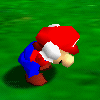
To navigate the courses more efficiently and complete certain missions, Mario has to use several moves. Along with the standard moves listed above, there are several additional moves that can be done by using button combinations.
In the following list, a "→" (right arrow) shows buttons to press in succession, and a "+" (plus sign) shows buttons to press simultaneously.
- While running,
 quickly turn around +
quickly turn around +  : Sideways Somersault
: Sideways Somersault - Upon hitting a wall,
 : Wall Jump
: Wall Jump  →
→  upon landing: Double Jump
upon landing: Double Jump →
→  →
→  : Triple Jump (while running); lift off (wearing the Wing Cap)
: Triple Jump (while running); lift off (wearing the Wing Cap) →
→  : Jump Kick (from a standstill); Midair Dive (while running)
: Jump Kick (from a standstill); Midair Dive (while running) →
→  →
→  : Punch → Punch → Kick
: Punch → Punch → Kick- In midair,
 : Ground Pound
: Ground Pound  +
+  : Crawl
: Crawl +
+  : Backwards Somersault (from a standstill); Long Jump (while running)
: Backwards Somersault (from a standstill); Long Jump (while running) +
+  : Sweep Kick (from a standstill); Slide Kick (while running)
: Sweep Kick (from a standstill); Slide Kick (while running)
Characters
| Name | Description |
|---|---|
 Mario |
The hero of the Mushroom Kingdom and the game's protagonist. He was invited to Mushroom Castle by Princess Peach, only to find that she had been kidnapped by Bowser. Mario has significantly expanded movement options to reflect the 3D environment of Super Mario 64. Some noteable new moves include the Triple Jump, the Wall Jump, the Ground Pound, and a punch-punch-kick. Unlike previous installments, Mario has a Health Meter and does not shrink in size if struck by an enemy. |
Non-playable characters
| Name | Description | Locations |
|---|---|---|
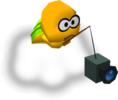 Lakitu Bros. |
A pair of cloud-riding turtles that are documenting Mario's quest to liberate Mushroom Castle and rescue Princess Peach from Bowser. One Lakitu Bro is with Mario throughout the entirety of the game, serving as an in-game explanation for the title's 3D camera controls. He is generally unseen, but his reflection can be spotted in a large mirror on the second floor of Mushroom Castle. They work for the organization Kingdom News Network. | All courses |
Princess Peach |
The ruler of the Mushroom Kingdom. She invited Mario to Mushroom Castle for cake, but she is missing by the time he arrives. Toad informs him that she was kidnapped by Bowser and sealed away within the Castle's walls. The game follows Mario's quest to restore the Castle's Power Stars and liberate the princess. | Castle Grounds[note 1] |
 Toad |
One of Princess Peach's attendants and an old friend of Mario's. He is one of several Mushroom Retainers that have been trapped inside the Castle. He gives Mario hints, tips, and words of encouragement when spoken to. Some Toads give Mario a Power Star if prompted. | Mushroom Castle |
 Bob-omb Buddies |
Friendly Bob-ombs that lack fuses. They reside in Bob-omb Battlefield, where they are at war with Big Bob-omb and his army. A Bob-omb Buddy is hidden away in nearly all subsequent courses. If spoken to, it prepares a cannon for Mario to use. The cannon remains open and accessible for all subsequent revisits. | Bob-omb Battlefield Whomp's Fortress Jolly Roger Bay Cool, Cool Mountain Shifting Sand Land Snowman's Land Wet-Dry World Tall, Tall Mountain Tiny-Huge Island Rainbow Ride |
 Koopa the Quick |
A large Koopa from Tiny-Huge Island. He challenges Mario to a footrace if spoken to and awards him a Power Star if beaten without using certain shortcuts. A diminutive enemy Koopa appears in courses that feature Koopa the Quick after he is beaten, which suggests some sort of correlation between the two. | Bob-omb Battlefield Tiny-Huge Island |
 Hoot the Owl |
A talking owl who roosts in a tree near Mario's starting position on Whomp's Fortress. Once woken up, Mario can grab onto Hoot's talons and be carried high into the air for a limited time. Hoot slowly descends while carrying Mario and drops him if he hangs on for too long, citing his weight. | Whomp's Fortress |
 Penguins |
Big, talking birds found in courses that feature snow. They are instrumental in several Power Star missions. The Mother Penguin found at the base of Cool, Cool Mountain awards Mario a Power Star if her lost chick Tuxie is returned to her, while the Big Penguin found in the cabin at the top of the mountain gives him a Star if beaten in a race. Revisiting this penguin after collecting all 120 Power Stars reveals that he has let himself go. The extra weight makes him a tougher opponent to out-sleigh. | Cool, Cool Mountain Snowman's Land |
Snowman (Cool, Cool Mountain) |
A giant snowman. He is the focus of the mission "Snowman's Lost His Head". His head is on a pedestal halfway down the mountain, while his sentient snowball body appears towards the top, by Mario's starting position. Either piece asks Mario to help put him together when prompted. Once assembled, the snowman gifts Mario a Power Star. | Cool, Cool Mountain |
 MIPS |
Princess Peach's pet rabbit.[8] He is found in the Castle's basement and flees if approached. He gives Mario a Power Star if caught. While captured, MIPS claims to be late for tea. | Mushroom Castle |
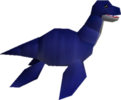 Dorrie |
A gentle giant that resembles a plesiosaur. It can be found swimming in an underground lake, where it can be ridden. Mario can steer Dorrie's body while standing on its back and lower its neck by performing a Ground Pound on its head. | Hazy Maze Cave |
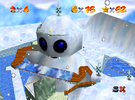 Snowman (Snowman's Land) |
An enormous snowman that can be climbed as if it were a mountain. Wooden platforms and slopes line his body, allowing Mario to ascend. Once he nears his head, the snowman starts to complain about an irritating crawling sensation on his body and tries to blow Mario off of him. A Power Star is one the very top of his head, and a deceptively spacious igloo can be found on his lower body. | Snowman's Land |
 Ukkiki |
A mischievous monkey who steals Mario's cap when grabbed. Mario must grab Ukkiki again in order to get it back, but the monkey runs away if approached and must be cornered. During "Mystery of the Monkey Cage", Ukkiki appears on the summit and taunts Mario. If grabbed, he begs to be released in exchange for a Power Star. | Tall, Tall Mountain |
 Yoshi |
An old friend of Mario's. He is a dinosaur-like creature with a long tongue. He can be found on the roof of Mushroom Castle once all 120 Power Star are collected. Yoshi awards the player with 99 extra lives and a special Triple Jump for fully completing the game. After which, he disappears off the side of the Castle. | Castle Grounds |
- ^ Only appears here after the final battle with Bowser in "Bowser in the Sky".
Courses
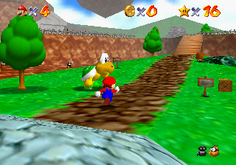
Levels are laid out inside paintings in the castle, or sometimes the walls themselves. They can also be found in holes, portals, oil pits, and inside a clock. Each world has seven Power Stars. Within each, one of which is gained by finding one hundred coins in the level. The other six Power Stars are found by performing "missions", accomplished by fighting bosses, winning races, etc. Every course has boundaries to limit Mario from going too far, either as a strict wall or an invisible boundary.
Castle Secret Stars
In addition to the main courses of the game and the Bowser Courses, there are also a few hidden courses that house several of the Castle's Secret Stars, as well as the three Cap Switches.
- The Princess's Secret Slide (2 Stars)
- The Secret Aquarium (1 Star)
- Bowser in the Dark World (1 Star)
- Toads' Stars (3 Stars)
- Tower of the Wing Cap (Wing Cap) (1 Star)
- Cavern of the Metal Cap (Metal Cap) (1 Star)
- Vanish Cap Under the Moat (Vanish Cap) (1 Star)
- MIPS (2 Stars)
- Bowser in the Fire Sea (1 Star)
- Wing Mario Over the Rainbow (1 Star)
- Bowser in the Sky (1 Star)
Three of the Toads in the castle give Mario a Power Star when talked to. One of the Toads is in a corner near the entrance to Hazy Maze Cave, another is under the staircase on the second floor, and the third is to the right of Tick Tock Clock.
Enemies
New enemies
Returning enemies
Bosses
There are various mini-bosses in some stages, but the primary boss is Bowser, who appears in three different levels. Each mini-boss holds a Power Star, except for Bowser, who holds a Big Key in his first two battles and a Jumbo Star in his third battle. This is a list of the bosses in the game.
| Image | Description | Location |
|---|---|---|
 Big Bob-omb |
A giant Bob-omb in Bob-omb Battlefield. He appears as the first boss in the game and has the first Power Star. | Bob-omb Battlefield |
 Whomp King |
A giant Whomp on top of Whomp's Fortress. He has the first Power Star, and after he is defeated, there is a tower on top of the fortress. | Whomp's Fortress |
 Big Boo |
A giant Boo that appears three times in Big Boo's Haunt. He initially appears once all the Boos in the mansion have been defeated, again in the underground Merry-Go-Round, and lastly on the top balcony of the mansion. | Big Boo's Haunt |
 Big Mr. I |
A giant Mr. I which only appears in the attic of Big Boo's Haunt. | |
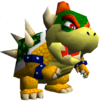 Bowser |
Bowser appears in Bowser in the Dark World, Bowser in the Fire Sea (where the arena tilts), and Bowser in the Sky (where he must be thrown three times). Mario needs to swing him by the tail clockwise or counterclockwise and hurl him at bombs on the outside of his circular arena. | Bowser in the Dark World Bowser in the Fire Sea Bowser in the Sky |
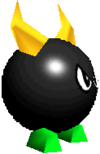 Big Bully |
Two of these giant Bullies appear in Lethal Lava Land. On both occasions, they try to knock Mario into the lava. | Lethal Lava Land |
Eyerok |
An ancient being composed of two stone hands with eyes on their palms. He appears when Mario blasts open the top of the pyramid in Shifting Sand Land and rides the elevator inside. | Shifting Sand Land |
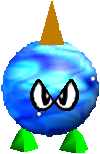 Chill Bully |
A large Bully made of ice. He tries to ram Mario onto a lethally frozen pond in Snowman's Land. | Snowman's Land |
 Wiggler |
A giant Wiggler, which becomes angry when his home in Tiny-Huge Island gets flooded. | Tiny-Huge Island |
Items
Throughout the game, Mario can make use of several items. Some items are out in the open, whereas others are found by breaking open yellow blocks or completing challenges.
| Image | Description | Image | Description |
|---|---|---|---|
 Coin |
A standard Coin found in the levels. When collected, it restores one point of Mario's Health Meter. | 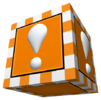 Yellow block |
A floating block that holds either coins, 1UP Mushrooms, or Power Stars. |
 Red Coin |
A red variant of the Yellow Coin, each worth two coins. Eight are scattered around most courses, and collecting them all will cause a Power Star to appear. They restore two points of Mario's Health Meter when collected. | 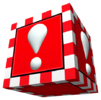 Red block |
A red block that holds a Wing Cap. Will become solid once the red Wing Cap Switch is pressed. |
 Blue Coin |
A blue variant of the Yellow Coin, each worth five coins. They usually appear after Ground Pounding Blue Coin Blocks or after defeating stronger enemies like a Mr. I. | 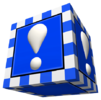 Blue block |
A blue block that holds a Vanish Cap. Will become solid once the blue Vanish Cap Switch is pressed. |
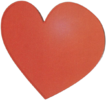 Spinning Heart |
A large heart than spins when Mario walks through it, which will recover his Health. The amount of Health it recovers and how fast it does so is dependent on how quickly Mario moves through it. | 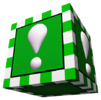 Green Block |
A green block that holds a Metal Cap. Will become solid once the green Metal Cap Switch is pressed. |
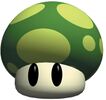 1UP Mushroom |
A green spotted mushroom that will give Mario an Extra Life when collected. | 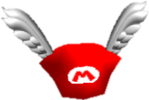 Wing Cap |
Once collected from a red block, the Wing Cap allows Mario to fly for a limited time. |
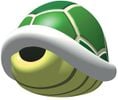 Koopa Shell |
A shell from a Koopa that Mario can ride, defeating enemies he runs over and allows him to move around the course quicker. Pressing |
 Vanish Cap |
Once collected from blue block, the Vanish Cap turns Mario invisible, allowing him to pass through wired cages and ignore enemies. |
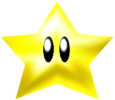 Power Star |
The main objective of the game. Collecting enough of them will allow Mario to open up ★ doors. |  Metal Cap |
Once collected from a green block, the Metal Cap turns Mario into metal, allowing him to walk underwater and defeat small enemies by simply running into them. |
Notable mistakes and errors
- At the end of the game, when speaking to Yoshi on the castle roof, he says "Mario!!! It that really you???" instead of "Mario!!! Is that really you???".
- If Mario is one star short of opening a ★ door, it will still refer to the word needed in the plural: "You need 1 more Stars" instead of "You need 1 more Star."
Those errors remained in the Virtual Console version. However, the former was removed and the latter was fixed in the remake, as Yoshi is a playable character, and the message that appears when Mario does not have enough stars to open a ★ door is "You need (number) more."
References to other games
- Super Mario Bros. - A carving of Mario and a carving of Bowser from this game appear on a pillars in Bowser in the Sky. An arrangement of the overworld theme plays on the title screen, and the underground theme can be heard in the music for Hazy Maze Cave and Wet-Dry World. There is also a small jingle used at the Power Star select screen which sounds identical to the first few notes of the overworld theme in this game.
- Super Mario World - The idea of Switch Palaces is, in a way, brought back. Also, when Yoshi is met, he says to Mario "It has been so long since our last adventure!", referring to this game. Also, the soundtrack follows the same composition technique used in Super Mario World in a similar way where there's a signature melody in the game that's heard across different levels in several variations (Bob-omb Battlefield, Snow Mountain, Slider).
- Super Mario World 2: Yoshi's Island - The theme used for invincibility in this game, specifically the string instruments playing in the background, is reworked into Wing/Vanish Mario's theme for Super Mario 64. The idea of collecting Red Coins first appeared in this title as well. Fly Guys appear as enemies. Ukikis also appear as non-playable characters.
- The Legend of Zelda: Ocarina of Time - This game was created using a modified engine of Super Mario 64's and was developed alongside it. Additionally, the notes for the Song of Storms are displayed as stars in the night paintings of the second floor in the Mushroom Castle[9].
References in later games
- Donkey Kong Country 3: Dixie Kong's Double Trouble! - Wrinkly Kong plays this game sometimes in her Save Caves. The theme for Wrinkly's Save Cave is also very similar to "Inside the Castle Walls," the music for the Mushroom Castle.
- Mario Kart 64 - The Mushroom Castle is hidden on Royal Raceway and its appearance is identical to its design in Super Mario 64. The castle grounds are also there and unchanged between the two games. The drawback is the castle is inaccessible. Penguins in Sherbet Land have an identical appearance and come in various sizes.
- Super Smash Bros. - Most of Mario's moves, animations and voice clips in this game are derived from the ones in Super Mario 64. Metal Mario appears as a boss. Two levels based on places here are also accessible, such as Metal Mario's stage and Peach's Castle. Although Luigi didn't appear in the game, his moves, animations and voice clips are identical to Mario's in Super Mario 64, except Luigi's voice clips are higher-pitched versions of Mario's.
- Paper Mario - This game starts the same way, with a letter being sent from Peach. Peach's Castle design in this game is similar to that used in the box art of Super Mario 64. Also, the main room is near identical (however, the doors lead to different rooms).
- Mario Party - The board Mario's Rainbow Castle is based on the secret course Tower of the Wing Cap. Mario's title screen (if he wins the board game under the title of being a Superstar) depicts him with the Wing Cap flying with the other playable characters.
- Mario Kart: Super Circuit - Peach's Castle reappears in the background of Peach Circuit, Mario Circuit 1 and Mario Circuit 4. The music for the Bowser Castle courses is a sped-up arrangement of Bowser's battle theme from this game.
- Super Smash Bros. Melee - Two stages based on areas from Super Mario 64 appear: Princess Peach's Castle (which also appears as a trophy) and Rainbow Ride. Metal Mario reappears as a boss and a trophy. Additionally, the Metal Box returns in this game as an item and a trophy. Mario still has his voice clips, moves, and animations and Luigi still has Mario-like voice clips, moves, and animations. One of Kirby's Stone forms is based on the Thwomp's design first used in this game.
- Super Mario World: Super Mario Advance 2 - A section of the music heard inside Peach's Castle plays on the status screen.
- Super Mario Sunshine - A brief clip of Mario's fight with Bowser is seen when F.L.U.D.D. scans Mario.
- Mario & Luigi: Superstar Saga - In Woohoo Hooniversity, a room with four blocks can be seen in it; one of them is a block from Super Mario 64. The name of the game is even mentioned in the description of the blocks, and the professors are trying to figure out why it vanishes when struck.
- Paper Mario: The Thousand-Year Door - The game starts in the same way, Peach sends Mario another letter.
- Mario Power Tennis - The music that plays during the minigame Artist On the Court is an arrangement of "Inside the Castle Walls."
- Super Mario 64 DS - This game is a remake of Super Mario 64. Also, at the start, Yoshi is on the roof and jumps down, a reference to the fact that he is there at the end of Super Mario 64.
- Mario Kart DS - Tick Tock Clock appears as a race track in this game. Several bosses found here also reappear in this game.
- Mario & Luigi: Partners in Time - The theme for Peach's Castle is a cover version of this game's castle theme. Also, ! Blocks appear in this game.
- New Super Mario Bros. - This game uses many things found in Super Mario 64, such as Dorrie, and a Bowser head closes in on the screen when Mario dies. Also, the Wing/Vanish Cap theme is present for Invincibility in this game. This is largely due to many assets in this game were reused from Super Mario 64 DS.
- Mario Strikers Charged - A cover of the music that plays in Big Boo's Merry-Go-Round is featured in this game, as the theme associated with Boo sidekicks.
- Super Mario Galaxy - The game starts in the same way, with Peach sending Mario another letter. Also, "Bowser's Road" is covered for Bowser's Star Reactor and Bowser's Dark Matter Plant. Also, the falling asleep idle animation returns.
- Super Smash Bros. Brawl - Music from Bob-omb Battlefield is unlockable, and the Rainbow Ride stage and Metal Box from the previous game return as well. Mario retains the moves and animations that originated in Super Mario 64.
- Mario Super Sluggers - Both songs that play when playing in Peach Ice Garden and going into said place in Challenge mode are arrangements of the music for Peach's Castle from this game.
- Mario & Luigi: Bowser's Inside Story - The music for when the Mario Bros. first enter Peach's Castle and when everyone is removed from Bowser's Belly is a cover of the Peach's Castle theme. Also, both games end in a view of a cake with Mario and Peach figures on it.
- Mario & Sonic at the Olympic Winter Games - In the Wii version, an arrangement of Cool, Cool Mountain's and Snowman's Land's music is used in Dream Snowball Fight. The main theme and the Bowser stage theme are also used. In the Nintendo DS version, the Cool, Cool Mountain theme is also rearranged as the second part of the Mario & Sonic Download Medley in Ultimate Figure Skating.
- New Super Mario Bros. Wii - Peach's Castle reappears in the game. Winning a Toad House minigame plays the jingle heard after exiting a course with a Power Star, and when revealing a pair of Bowser or Bowser Jr. icons in the Power-up Panels minigame, the short tune that plays when trying to enter a locked door is heard.
- Super Mario Galaxy 2 - In both Tall Trunk Galaxy (during the mission "Tall Trunk's Big Slide") and Rolling Coaster Galaxy, an arrangement of The Princess's Secret Slide's music plays at a moment. Also, the Whomp's Fortress reappears as the Throwback Galaxy, alongside Bob-omb Buddies and the Whomp King. Both games start with Peach sending a letter to Mario. Also, an orchestral cover of "Bowser's Road" can be heard in Bowser's Lava Lair and Bowser's Gravity Gauntlet.
- Super Mario 3D Land - The sound effect of Mario falling from heights is reused, plus the platforming style is mixed together with Super Mario Bros. 3 and Super Mario Galaxy. Also, when Mario waits outside a purple Mystery Box on the map screen, the endless stairs music from Super Mario 64 can be heard.
- Mario Kart 7 - Metal Mario appears as a playable character.
- Mario Tennis Open - A cover of the music for Peach's Castle is used for Peach's Palace. On the Bowser's Castle court, a cover of the Bowser battle music is played.
- New Super Mario Bros. 2 - The first few notes of the theme for Peach's Castle are played during the intro.
- Paper Mario: Sticker Star - The music for The Princess's Secret Slide is covered during the minecart part of Bowser's Snow Fort.
- Super Mario 3D World - A cover of The Princess's Secret Slide's music plays when riding Plessie. In Shifty Boo Mansion, a level in Super Mario 3D World, there is a Green Star hidden behind a portrait of a Boo that can be entered like the pictures in Peach's Castle.
- Mario Kart 8 / Mario Kart 8 Deluxe - The merry-go-round music from Big Boo's Haunt can be heard near the Aqua Cups ride in Water Park.
- Mario Party: Island Tour - A cover of "Koopa's Road" plays in Bowser's Peculiar Peak.
- Super Smash Bros. for Nintendo 3DS / Wii U - Peach's Castle (64) appears a DLC stage, which returns from the original Super Smash Bros. In Super Smash Bros. for Wii U, the original version of the main theme returns, and an arranged version of the theme is featured in the DLC stage in both games.
- Super Mario Maker - The victory theme and the Game Over theme are used when the Mario, Silver Mario, and Gold Mario costumes complete a level or lose a life, respectively. Additionally, when a Super Star is obtained, the Wing Cap theme is played for the Mario costume and the Metal Cap theme is played for the Silver Mario and Gold Mario costumes.
- Mario & Luigi: Paper Jam - King Bob-omb reappears as a boss in this game.
- Super Mario Odyssey - The game marks a return to the non-linear, open-ended style of gameplay for 3D Mario platformers established by this game. An arrangement of Bowser's theme can be heard in the song "Break Free (Lead the Way)". The Mushroom Kingdom is filled with many references to Mario's past, mostly Super Mario 64. Its regional currency are based on design of the coins from Super Mario 64. Additionally, Mario can dress up as the original Super Mario 64 model of himself by buying the hat and costume separately at the Mushroom Kingdom Crazy Cap shop. Also, the Metal outfit is just the Super Mario 64 suit, but with a metal coat. The jingle that plays when collecting a Power Moon is an arrangement of the course jingle from Super Mario 64. Also, the brochure held by Hint Toad and in the Odyssey depicts Bob-omb Battlefield.
- Mario Tennis Aces - An arrangement of Bowser's level and battle themes is played during the final battle against Bowcien in Adventure Mode.
- Super Smash Bros. Ultimate - The Peach's Castle stage returns in this game, along with Princess Peach's Castle and Rainbow Cruise.
- Super Mario Maker 2 - The original "Slider" theme is featured as a sound effect under the "Musical" category, represented by the Nintendo 64 logo.
Appearances in other media
It has been requested that this section be rewritten. Reason: Explain in which books it has been adapted
This section is under construction. Therefore, please excuse its informal appearance while it is being worked on. We hope to have it completed as soon as possible.
Template:More images Super Mario 64 has received various manga adaptations.
- Super Mario-Kun SM64 Bowser hacking enemies.jpg
The Headless Snowman
Media
- For a complete list of media for this subject, see List of Super Mario 64 media.
| File info 1:12 |
| File info 0:29 |
| File info 0:30 |
| File info 0:29 |
| File info 0:29 |
| File info 1:14 |
Reissues
Super Mario 64: Shindō Pak Taiō Version
Super Mario 64: Shindō Pak Taiō Version is a version of the original game released in Japan on July 18, 1997 that includes Rumble Pak support. This game is the same as the international release of the game, as it retains all of the glitch fixes as well as graphical and sound changes (except Mario calling Bowser by his name in the "So long Bowser!"[10] voice clip, which was changed to "Buh-bye!"). Other differences include a new title screen Easter egg and the fixing of the "backwards long jump" glitch. This version was re-released for the Virtual Console on Wii in Japan on December 2, 2006, then on Wii U on April 8, 2015.
Super Mario 64 DS
- Main article: Super Mario 64 DS
Super Mario 64 DS is the remake of the game for the Nintendo DS, bearing some new features on its storyline, gameplay and graphics. Unlike Super Mario 64, Mario is not the only playable character (nor is he even available at the start, the only character available at the start of the game is Yoshi); Yoshi, Luigi, and Wario also join the adventure in order to rescue Princess Toadstool from the hands of Bowser. Other new features within the game include a multi-player mode, in which up to four players can play simultaneously on each Nintendo DS connected together locally; minigames to play with each character, and new additions to the story mode such as new missions and levels.
Super Mario 3D All-Stars
- Main article: Super Mario 3D All-Stars
Super Mario 3D All-Stars is a compilation game for the Nintendo Switch featuring high-definition remasters of Super Mario 64 (specifically Shindō Pak Taiō Version[11], its first international release), Super Mario Sunshine, and Super Mario Galaxy. It was released on September 18, 2020 as part of the 35th anniversary of Super Mario Bros. The game is displayed in 720p resolution and contains redone textures.
Soundtrack
- Main article: Super Mario 64 Original Soundtrack
Super Mario 64's soundtrack comprises thirty-four music cues composed by veteran composer Koji Kondo. The majority of the cues are new material, with some being interpretations of familiar melodies from earlier media. It also includes hundreds of sound effects; sound designer Yoji Inagaki felt that sound effects were equally as important as music.[12]
An album tying in with the game was published by Pony Canyon under license from Nintendo as the first of ten soundtracks in the Nintendo 64 Sound Series. In addition to all of the game's music cues, the album includes Mario's opening voiceover and a piano arrangement of the Piranha Plant's lullaby.
The music for Super Mario 64 was scored using the Akai S1000 synthesizer, Best Service's Voice Spectral, Digidesign's SampleCell II CD-Rom Library #1, E-mu Systems' Proteus/1 synthesizer, ILIO's Synclavier World & Orchestral, Optical Media International's Universe of Sounds: Sonic Images Vol. 1, Q-Up Arts' The Denny Jaeger Private Collection Vol. 1, Rarefaction's A Poke in the Ear With a Sharp Stick, Roland's JD-990, L-CD702 Orchestral Family Vol. 1 and Sound Canvas SC-88 synthesizers, and Spectrasonics' Bass Legends and Supreme Beats.[13] Many of the sound effects in the game were sourced from Sound Ideas' General Series 6000 and Series 1000 sound effects libraries and the sound effects libraries of American film studios Warner Bros. and Universal Pictures.[14]
Gallery
- For this subject's image gallery, see Gallery:Super Mario 64.
Mario and Bowser
- Goomba SM64 art.jpg
Version differences
There are a total of four Nintendo 64 releases of Super Mario 64: the original Japanese version, the American release, the European and Australian release, and the Japanese Super Mario 64: Shindō Pak Taiō Version re-release.
Changes to the American release
Text changes
- The script is exclusively in English.
- Princess Peach signs her letter with a large, pink "Peach". In the Japanese release, she signs her letter in normal sized black text.
Audiovisual changes
- The entrance to Jolly Roger Bay is changed. In the original release, it is a painting of bubbles in a blue frame. In the American release, it is a painting of a sunken ship in a gold frame.
- In the Japanese version, the animation that plays when Mario collects a key after defeating Bowser depicts him dancing with a Power Star, as he does after completing a Power Star mission in all versions of the game. In the American release, this is changed to a new animation in which Mario dances with the key itself.
- The unused "key" HUD icon is removed from this version. It is replaced with a corrupted graphic.
- The J, Q, V, Z, %, &, !, and ‼ characters are removed from the game's multicolored font, and replaced with corrupted graphics similar to the key. None of these symbols are actually used anywhere in the game.
- The Chain Chomp's bark has been changed to a completely different sound.
- The Red Coin sound effect increases in pitch with each coin collected. In the Japanese release, all red coins make the same sound.
- The intro cutscene has several additional sound effects not present in the original release:
- The blowing of wind when Lakitu is flying.
- The click of the camera shutter when the in-game camera moves to Lakitu's perspective.
- The spring sound and voice line "Ha ha!" when Mario jumps out of the pipe.
- A sound effect not present in the Japanese game plays when Mario exits a course through the pause menu.
- When entering certain substages, such as Tower of the Wing Cap, the Power Star collection sound effect plays.
- When Lakitu appears to explain things to Mario, a short tune entitled "Lakitu's Message" plays. Since this tune is not in the original Japanese release, it isn't found on the official soundtrack.
- The American release adds more voice acting for Mario:
- "Hello!" when Mario's face greets the player on the title screen.
- "Okey-dokey!" when the player chooses a save file.
- "Let's-a go!" when the player chooses a star before entering a course.
- "Game over!" when Mario runs out of lives.
- "Press START to play!" during the title screen demo.
- "Boing!" when Mario jumps off a Spindrift.
- "I'm-a tired!" and the names of various pastas when Mario is sleeping.
- "Mamma mia!" when falling out of a non-painting course after Mario loses a life.
- In the original Japanese version, Mario says "Here we go!" when he throws Bowser. In the American version, he only says "Here we go!" when throwing Bowser a short distance. When he throws Bowser a long distance, he instead says "So long Bowser!". [10]
- Similarly, when Mario hits a wall in the Japanese version, he grunts. In the American version, Mario grunts if he hits a wall at a low speed, but says "D'oh!" if he Long Jumps or dives into a wall.
- When Mario Triple Jumps in the Japanese release, he says "Yahoo!". In the American release, he randomly says any of "Yahoo!", "Wha-ha!", or "Yipee!"; however, he says only "Yahoo!" when using the improved Triple Jump obtained after talking to Yoshi.
- All of Princess Peach's voice acting is new in this version of the game.
Fixed glitches
- When Mario steps on one of the Cap Switches, a text box is triggered that explains the function of the switch. In the Japanese release, this text box causes the action in-game to pause until the text box is closed. If a Power Star is collected before this text box appears, the star will not vanish as it is supposed to do upon collection. In the American release, the text box does not cause the action to pause, which fixes this glitch.
- If 1000 coins are collected, the coin counter is intended to immediately set itself back to 999 coins. In the Japanese release, it instead sets the life counter to 999. Because the life counter is stored in memory as a one byte wide signed field, this causes an overflow, and Mario's life total becomes -25. The American release correctly sets the coin counter to 999, rather than the life counter.
- The first two times Bowser is defeated, he leaves behind a key. If Mario is standing where the key will land and the player presses
 to activate the first person camera, Mario will keep looking that way during the key collection cutscene.
to activate the first person camera, Mario will keep looking that way during the key collection cutscene. - In Shifting Sand Land's pyramid, collecting the fifth secret may cause the audio to stop playing. If this happens, attempting to leave the course in any way will trigger a game crash.
- If Mario exits a course while standing on a moving platform, he will retain his momentum when the Mushroom Castle loads. This will cause Mario to spawn in an abnormal location.
Level design changes
- In the mission Blast to the Stone Pillar, the Power Star is in a yellow block, rather than in the open as it was in the Japanese release.
- In the mission Li'l Penguin Lost, the Power Star's spawn location has been moved from directly above the Mother Penguin to an empty area adjacent to her. This was apparently done because the penguin's hit box made it difficult to collect the star in its original location.
Changes to the European and Australian release
These releases feature all the changes of the American release, plus the following additional changes:
Text changes
- The script can be switched between English, German, and French.
- The American version's "Sound" menu has been renamed to "Options", reflecting the fact that the in-game language can be changed from this menu.
- The characters Ä, Ö, and Ü have been added to the multicolored font, to allow proper representation of the German language. The Ü character is not actually used anywhere in the game. V and Z, which are present in the Japanese release but changed to corrupted characters in the American release, are restored in this edition of the game.
Audiovisual changes
- The copyright date on the title screen is changed to reflect the release year of the European and Australian editions. The trademark symbol was changed for unknown reasons, and the logo is slightly narrower.
- The intro screen says "PRESS START" in the NTSC versions, but just "START" in the PAL version. The text was also moved slightly to the left in the PAL version.
- The NTSC versions have slight letterboxing while the PAL version does not. This is most noticeable with the gap between the edge of the HUD elements and the edge of the screen.
- In the intro, Mario jumps out of a pipe and a variation on the classic Mario pipe sound effect plays. In this edition of the game, the sound effect plays at a much quieter volume.
- The sound of a Big Star Door closing is now more similar to the sound of the door opening.
- The yellow coin collecting sound is slightly slowed down.
- The sound effect of grabbing and then releasing Mario's face on the title screen is changed.
- Mario's Double Jump sound is different.
Gameplay Changes
- This version of the game outputs a signal compatible with the PAL television standard, rather than the NTSC standard used by the American and Japanese releases. Therefore, it outputs 25 frames per second instead of 30. This causes everything in the game to happen at 5/6ths of the speed that it happens in the American release.
Changes in Super Mario 64: Shindō Pak Taiō Version
This release features all the changes of the American release, plus the following additional changes:
Text changes
- The original Japanese script is restored.
- Text that mentioned pressing
 to read signs in both the original Japanese and localized scripts now additionally mentions
to read signs in both the original Japanese and localized scripts now additionally mentions  can be pressed as an alternative.
can be pressed as an alternative.
Audiovisual changes
- The copyright date on the title screen is updated to reflect the release date of Super Mario 64: Shindō Pak Taiō Version. The trademark symbol is changed.
- A notice in the lower right corner of the intro screen informs players that this release is compatible with the Rumble Pak.
- If the player presses
 on the intro screen, the background will be filled with images of Mario's face. These faces are copied from the frame buffer, so they move in synchronisation with the the modeled Mario face.
on the intro screen, the background will be filled with images of Mario's face. These faces are copied from the frame buffer, so they move in synchronisation with the the modeled Mario face. - The voice line "So long Bowser!"[10] is changed to "Buh-bye!", likely since Bowser's Japanese name is Koopa.
- Mario's Double Jump sound is a higher pitched version of the same sound from the European and Australian version.
- One of Mario's single Jump sounds is higher-pitched.
- Mario faces the camera after grabbing a tree.
Gameplay changes
- The game is compatible with the Rumble Pak.
- The "backwards long jump" glitch has been fixed. Although the move itself can be performed, the player is prevented from gaining high speeds.
- The Power Star in Blast to the Stone Pillar is out in the open like in the original Japanese release rather than in a yellow block like in the international releases.
Pre-release and unused content
- Main article: List of Super Mario 64 pre-release and unused content
One unused asset is the Blargg, which is still in the game's data, that would've appeared in the Lethal Lava Land, Bowser in the Fire Sea, and Wing Mario Over the Rainbow stages. Also, Big Boo held a key instead of a Star inside of him. The purpose of the keys was to unlock a variety of the various doors in Big Boo's Haunt - there was even a "key counter". 32 levels were planned for the game, but only fifteen of them made it into the final product.
Reception
Super Mario 64 received critical acclaim, garnering a score of 9.8 from IGN, 9.4 from GameSpot, and 9.75 from Game Informer. Although it was criticized for its camera system and difficulty, it was praised for its graphics, level design, soundtrack, and the Mario series shift from 2D to 3D. Sometime after the game's release, rumors about secret glitches, stars, and hidden characters circulated. Among the most famous is the widely publicized hoax that Luigi was hidden and fully playable, causing bogus rumors to circulate on how to unlock him.
| Reviews | |||
|---|---|---|---|
| Release | Reviewer, Publication | Score | Comment |
| N64 | Doug Perry, IGN | 9.8/10 | "In fact, this game is exactly as one might hope it would be: Mario in 3D. More freedom, more space, more options, better graphics, improved and elaborated control schemes -- it's all there. Possibly the greatest videogame achievement ever. Don't rent. Buy." |
| N64 | Gamespot Staff, GameSpot | 9.4/10 | "Mario 64 is a game that rewards the curious, the original, and in some cases the bludgeoningly stubborn and tenacious. If Mario 64 is even a rough indication of what's to be expected from Nintendo, or from games in general, then we just might have a revolution of sorts in our very hands." |
| Wii | Corbie Dillard, Nintendo Life | 10/10 | "Finishing the game won't take you too long but as with most Mario games that's not really the point, it will take you weeks (and quite possibly months) to discover all the secrets contained within this game. " |
| Aggregators | |||
| Compiler | Platform / Score | ||
| Metacritic | 94 | ||
| GameRankings | 96.41% | ||
Sales
Super Mario 64 is the best selling game for the Nintendo 64, selling 11.62 million copies worldwide, as of December 31, 2009.
Super Mario 3D All-Stars description
- "Princess Peach has invited Mario to her castle to enjoy some cake! On his arrival, he's greeted by an eerie silence...until Bowser's laughter echoes through the halls. Thus begins an adventure to rescue the princess by exploring the magical worlds within the castle's many enchanted paintings. This first 3D action game in the Super Mario series launched alongside the Nintendo 64 system. The introduction of the analog Control Stick set a new standard for later games in the series."
Glitches
- Main article: List of Super Mario 64 glitches
A famous glitch is the Backwards Long Jump, which will let Mario slide upward on any staircase, including the endless stairs. Another famous glitch is the Black Room of Death, which traps Mario behind the boundaries of the castle walls. It could be achieved using several ways, including using the Backwards Long Jump glitch. Another rather known glitch is the cloning glitch, often used to collect more coins than the actual number of coins in the game.
As in many other N64 titles, the cartridge can be tilted in the console to achieve messed up results, for example Mario's body will flip horizontally, but he can still be controlled. Also, the music will be heavily corrupted.
In the Japanese in multiple areas of the game, there are unintended invisible walls that Mario can bump into. An example is the one in Tall, Tall Mountain just above the wooden log.
While collecting one of Bowser's keys, if the player can press ![]() and looks somewhere, Mario will keep looking that way during the key collection cutscene. This glitch is only possible in the first Japanese version of the game as when it was ported to other regions, the glitch was fixed.
and looks somewhere, Mario will keep looking that way during the key collection cutscene. This glitch is only possible in the first Japanese version of the game as when it was ported to other regions, the glitch was fixed.
Using a good timed Triple Jump on the slope near the castle, Mario can climb the castle without the cannon. Also, when Mario reaches a corner, he can fall down slightly and grab onto a ledge. Mario can then pull himself back up onto the roof, at which point he will lose a life. For unknown reasons, he also loses his hat. This occurs because when Mario grabs the ledge, he is out of bounds, but the game waits until Mario pulls himself back up before causing him to lose a life. Something similar can happen if a door leads out of bounds or into a wall, but that can only happen through modding or glitches.
Angled Dive
When Mario enters the water, the angle Mario was facing before entering is preserved in a datum, therefore, when Mario jumps and lands on dry land, the next dive Mario performs will start with this angle. A few frames afterward, the angle will fix itself and the dive will be completed correctly. Several things "reset" the angle, including grabbing a ledge, shooting from a cannon, changing areas and jumping while facing a slope. This glitch does not affect the dive itself, just the animation.
Staff
- Main article: List of Super Mario 64 staff
Game director
- Shigeru Miyamoto
Assistant directors
- Yoshiaki Koizumi
- Takashi Tezuka
Mario face programmer
- Giles Goddard
Course designers
- Kenta Usui
- Naoki Mori
- Yoshiki Haruhana
- Makoto Miyanaga
- Katsuhiko Kanno
Names in other languages
| Language | Name | Meaning | Notes |
|---|---|---|---|
| Japanese | スーパーマリオ64[?] Sūpā Mario Rokujūyon |
Super Mario 64 | |
| Chinese (simplified) | 神游马力欧 (iQue Player) Shényóu Mǎlì'ōu 超级马力欧64 (Super Mario 3D All-Stars)[15] Chāojí Mǎlì'ōu Liùshísì |
iQue Mario Super Mario 64 |
|
| Chinese (traditional) | 超級瑪利歐64[16] Chāojí Mǎlì'ōu Liùshísì |
Super Mario 64 |
Trivia
This trivia section is overly long. Please relocate any relevant information into appropriate sections and articles.
- Super Mario 64 was one of the games featured at The Art of Video Games, an exhibition held at the Smithsonian American Art Museum in 2012.[17] The game won voting in the "action" category for the Nintendo 64, beating out Banjo-Kazooie and Star Wars: Shadows of the Empire.
- Like most Nintendo 64 games at the time, Super Mario 64 does not use the full 64-bit capabilities of the console, but actually runs in 32-bit.
- Super Mario 64 is one of the few mainline Mario games, along with Super Mario Sunshine, to not have a single reference to Luigi that can be accessed through the normal course of play (as model and texture assets exist in the source code for Super Mario 64, but go unused). However, he is playable in the game's DS remake.
- Despite Super Mario 64 and its remake both receiving an official China (Simplified Chinese) release by iQue, Super Mario 3D All-Stars does not include Chinese script in-game and only offers menu translation for the Chinese-speaking audience.
- During the development of Super Mario 64, the title screen featuring Mario's face came from 3D struggles leading Shigeru Miyamoto to suggest playing with Mario's model like a programmer. Additionally, Miyamoto took up swimming at the time, which is reflected in Mario's breast stroke move.[18]
References
- ^ GameFaqs - The top 10 games Ever
- ^ Edge Online - The 100 Best Games to Play Today
- ^ Official Nintendo Magazine - 100 Best Nintendo Games
- ^ GameSpot - 15 Most Influential Games of All Time
- ^ http://gamingafterhours.com/2014/06/24/super-mario-64dd-version-discovered-in-japan/
- ^ http://www.vgchartz.com/game/2278/super-mario-64/
- ^ https://www.gamespot.com/articles/wii-vc-47m-downloads-100-games/1100-6171850/
- ^ Shogakukan. 2015. Super Mario Bros. Hyakka: Nintendo Kōshiki Guidebook, Super Mario 64 section, page 85. 「ピーチ姫の飼っているウサギ。」 ("Princess Peach’s pet rabbit.")
- ^ HiteiGG's Twitter post, showing the Song of Storms in Super Mario 64
- ^ a b c Nintendo 1996 Holiday Season Press Kit (Oct 1996) - "SHHH...MARIO'S GOING TO SAY SOMETHING!" n64collection.co.uk (May 2, 2015). Retrieved January 30, 2022. (Wayback Machine)
- ^ Master0fHyrule (September 18, 2020). 5 MAJOR Differences In Super Mario 64 That You Will Miss! (Super Mario 3D All Stars). YouTube. Retrieved September 23, 2020.
- ^ https://www.nintendo.co.jp/nom/0106/koukaon/interv/talk/index.html
- ^ https://docs.google.com/spreadsheets/d/1JJBlHHDc65fhZmKUGLrDTLCm6rfUU83-kbuD8Y0zU0o/edit?pli=1#gid=717751203
- ^ https://soundeffects.fandom.com/wiki/Super_Mario_64
- ^ 《超级马力欧64》、《超级马力欧阳光》和《超级马力欧银河》。 3款历代的3D马力欧收录在Nintendo Switch的《超级马力欧 3D 收藏辑》,将于9月18日发售! Nintendo HK. Retrieved September, 2020.
- ^ 《超級瑪利歐64》、《超級瑪利歐陽光》和《超級瑪利歐銀河》。3款歷代的3D瑪利歐收錄在Nintendo Switch的《超級瑪利歐 3D 收藏輯》,將於9月18日發售! Nintendo HK. Retrieved September, 2020.
- ^ http://americanart.si.edu/exhibitions/archive/2012/games/#games
- ^ MacDonald, Keza (September 14, 2020). Super Mario at 35: Mario's makers on Nintendo's most enduring mascot. The Guardian. Retrieved November 15, 2020.
External links
| Nintendo 64 games | ||
|---|---|---|
| Super Mario franchise | Super Mario 64 (1996) • Mario Kart 64 (1996) • Mario no Photopi (1998) • Mario Party (1998) • Mario Golf (1999) • Mario Artist: Paint Studio* (1999) • Mario Party 2 (1999) • Mario Artist: Talent Studio* (2000) • Mario Artist: Communication Kit* (2000) • Mario Tennis (2000) • Paper Mario (2000) • Mario Artist: Polygon Studio* (2000) • Mario Party 3 (2000) • Dr. Mario 64 (2001) | |
| Donkey Kong franchise | Diddy Kong Racing (1997) • Donkey Kong 64 (1999) | |
| Yoshi franchise | Yoshi's Story (1997) | |
| Crossovers | Super Smash Bros. (1999) | |
